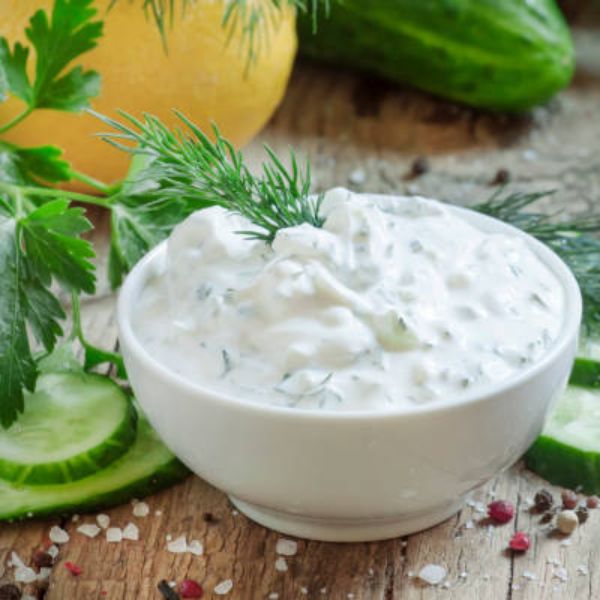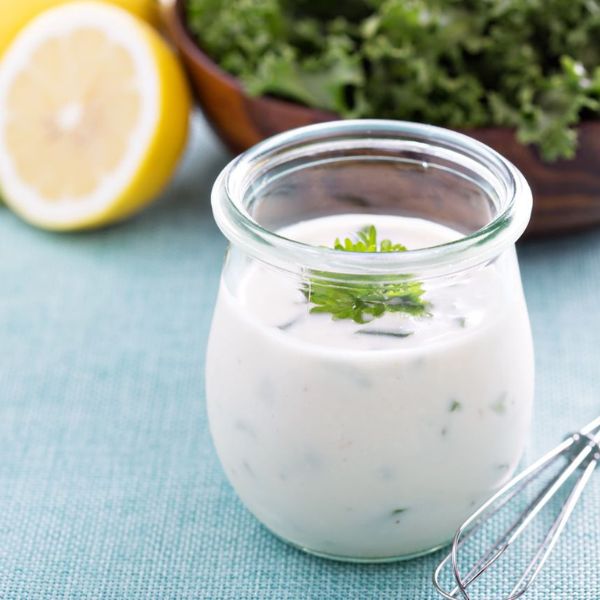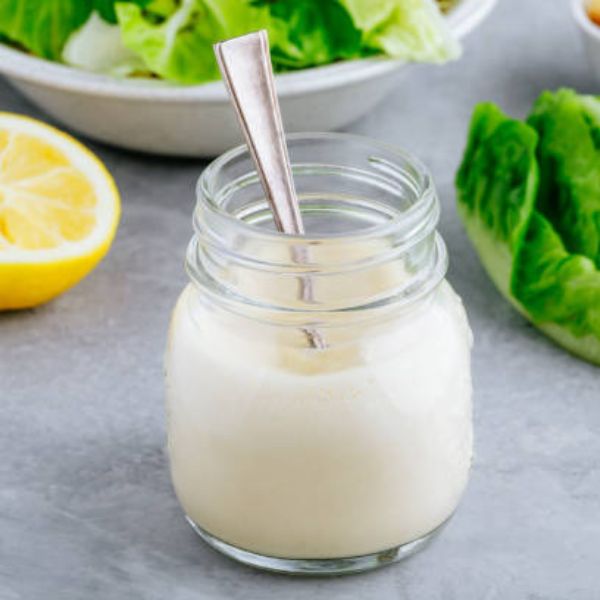Traditional ranch dressing is typically made with a base of buttermilk or sour cream, both of which are dairy products.
These ingredients give ranch dressing its creamy and tangy flavor.

However, for those who cannot consume dairy or choose to avoid it, there are several dairy-free options to consider.
One popular dairy-free alternative to traditional ranch dressing is made with a base of plant-based ingredients such as soy, almond, or coconut milk.
These non-dairy milks provide a creamy texture and can be combined with other ingredients like vinegar, garlic, and herbs to create a flavorful dairy-free ranch dressing.
Many brands now offer dairy-free ranch dressings that are readily available in grocery stores.
Another option for those avoiding dairy is to make homemade ranch dressing using dairy-free substitutes.
For example, instead of buttermilk or sour cream, you can use dairy-free yogurt or mayonnaise as the base.
By adding herbs, spices, and other flavorings, you can create a delicious dairy-free ranch dressing that suits your taste preferences.
It’s important to note that while dairy-free ranch dressings are suitable for individuals with lactose intolerance or dairy allergies, they may not be suitable for those with severe milk protein allergies.
Some dairy-free ranch dressings may still contain traces of milk proteins, so it’s essential to read the ingredient labels carefully.
In addition to dressings, there are also dairy-free ranch-flavored snacks available in the market.
These snacks, such as chips or crackers, are seasoned with ranch flavorings but do not contain any dairy ingredients.
They provide a dairy-free alternative for individuals who enjoy the taste of ranch but cannot consume dairy.
while traditional ranch dressing does contain dairy, there are plenty of dairy-free alternatives available for those who cannot consume dairy or choose to avoid it.
Whether it’s store-bought dairy-free ranch dressings or homemade versions using dairy-free substitutes, individuals can still enjoy the creamy and tangy flavor of ranch without dairy.
Additionally, dairy-free ranch-flavored snacks offer a tasty option for those looking for a dairy-free ranch experience.
Understanding Ranch Dressing
Ranch dressing is a popular condiment that is loved by many for its creamy and tangy flavor.
However, there is often confusion surrounding whether or not ranch dressing contains dairy.
To answer this question, yes, ranch dressing typically contains dairy products.
The base of traditional ranch dressing is made from a combination of buttermilk and mayonnaise.
Buttermilk, which is a key ingredient in ranch dressing, is a dairy product that is made from the liquid left behind after churning butter.
It has a slightly tangy taste and adds a creamy texture to the dressing.
Mayonnaise, another component of ranch dressing, is also made with eggs and oil, which are both non-dairy ingredients.
However, some mayonnaise brands may contain small amounts of dairy, so it is important to check the label if you have specific dietary restrictions.
In addition to the base ingredients, ranch dressing often includes a variety of herbs and spices such as garlic, onion, dill, and parsley.
These ingredients not only enhance the flavor of the dressing but also contribute to its overall texture and appearance.
Some commercial ranch dressings may also contain additional ingredients like sour cream or yogurt, which are both dairy products.
It is worth noting that there are alternatives to traditional ranch dressing that are dairy-free.
These options are often made with plant-based ingredients such as soy, almond, or coconut milk.
These dairy-free ranch dressings can be just as flavorful and creamy as their dairy-containing counterparts, making them suitable for individuals with lactose intolerance or those following a vegan diet.
To further understand the presence of dairy in ranch dressing, let’s consider a popular brand, Hidden Valley Ranch.
Their original ranch dressing contains buttermilk, which is a dairy product.
However, they also offer a dairy-free version of their ranch dressing, which is made with soy milk instead of buttermilk.
This demonstrates that while traditional ranch dressing does contain dairy, there are alternatives available for those who prefer or require a dairy-free option.
Ranch dressing does typically contain dairy, specifically in the form of buttermilk and mayonnaise.
However, there are dairy-free alternatives available for individuals with dietary restrictions or preferences.
It is important to read the labels and ingredients list to ensure that the ranch dressing you choose aligns with your specific needs.
Whether you opt for the traditional dairy-containing version or a dairy-free alternative, ranch is liked by many for its delicious, creamy and tangy flavor.
The Ingredients of Ranch Dressing

To understand if ranch dressing contains dairy, we need to examine its key components.
Mayonnaise, a primary ingredient in ranch dressing, is typically made from eggs, oil, and vinegar or lemon juice.
While eggs are a dairy-free ingredient, it is important to note that some individuals with dairy allergies may also be allergic to eggs.
Therefore, it is essential to check the label or make homemade ranch dressing if you have specific dietary restrictions.
Buttermilk is another ingredient commonly found in ranch dressing.
Traditionally, buttermilk is made by fermenting milk with lactic acid bacteria, giving it a tangy flavor.
However, it is important to note that buttermilk is not dairy-free.
It is a byproduct of the butter-making process and contains small amounts of milk solids.
Therefore, individuals with lactose intolerance or dairy allergies should be cautious when consuming ranch dressing that contains buttermilk.
To cater to individuals with dietary restrictions, many brands offer dairy-free or vegan versions of ranch dressing.
These alternatives often use plant-based ingredients like soy or almond milk instead of traditional dairy products.
Additionally, they may replace mayonnaise with vegan alternatives made from ingredients like tofu or cashews.
These dairy-free ranch dressings provide a suitable option for those who follow a vegan or dairy-free diet.
While traditional ranch dressing contains dairy in the form of buttermilk, there are dairy-free alternatives available in the market.
It is essential to read the labels carefully and choose the appropriate option based on your dietary needs.
Whether you prefer the classic ranch dressing or opt for a dairy-free version, there are plenty of options to enjoy this versatile condiment.
The Vegan and Dairy-Free Options

One popular option for those following a vegan or dairy-free lifestyle is to make ranch dressing using non-dairy milk, such as almond milk or soy milk, as a substitute for the traditional dairy ingredients.
These non-dairy milk alternatives provide a creamy texture and can be easily flavored with herbs and spices to mimic the taste of traditional ranch dressing.
Additionally, there are also pre-made vegan ranch dressings available in stores, made with plant-based ingredients like cashews, tofu, or coconut milk.
Another alternative for those avoiding dairy is to opt for ranch dressings that are specifically labeled as “dairy-free” or “vegan”.
These dressings are typically made with a combination of vegetable oils, vinegar, and various herbs and spices to create a similar flavor profile to traditional ranch dressing.
Some popular brands even offer a range of dairy-free options, allowing individuals to choose from different flavors and textures.
It’s important to note that while these dairy-free and vegan options are suitable for individuals with lactose intolerance or those following a plant-based diet, they may not be suitable for individuals with allergies to nuts or soy.
It’s always recommended to carefully read the ingredient labels and consult with a healthcare professional if you have any dietary restrictions or concerns.
In addition to the store-bought options, many people also enjoy making their own dairy-free ranch dressing at home.
This allows for complete control over the ingredients used and allows for customization based on personal preferences.
Some popular homemade dairy-free ranch dressing recipes include using ingredients like cashews, tahini, or even avocado as a base, combined with herbs, spices, and vinegar for flavor.
While traditional ranch dressing does contain dairy, there are now numerous vegan and dairy-free options available.
Whether you choose to make your own dairy-free ranch dressing at home or opt for store-bought ranch dressing alternatives, there are plenty of delicious options to satisfy your craving for this classic dressing without compromising your dietary preferences.
The Importance of Reading Labels

One reason why reading labels is essential is that some ranch dressings do contain dairy products.
Traditional ranch dressings often include ingredients such as buttermilk, sour cream, or yogurt, which are all dairy-based.
These ingredients give ranch dressing its creamy and tangy flavor.
For individuals who are lactose intolerant or have dairy allergies, consuming ranch dressings with these ingredients can lead to uncomfortable symptoms such as bloating, gas, or even more severe allergic reactions.
However, with the increasing demand for dairy-free options, many brands now offer ranch dressings that are specifically labeled as dairy-free or vegan.
These dairy-free alternatives are typically made with plant-based ingredients such as soy, almond, or coconut milk.
They are carefully formulated to mimic the taste and texture of traditional ranch dressings while being free from any dairy products.
Reading labels allows individuals to identify these dairy-free options and enjoy ranch dressing without any adverse effects.
Furthermore, reading labels goes beyond just identifying the presence of dairy.
It also helps individuals make informed choices based on their dietary preferences or restrictions.
For example, some people may choose to avoid certain additives or preservatives commonly found in ranch dressings.
By reading labels, they can identify dressings that are made with natural ingredients and avoid those that contain artificial flavors, colors, or high levels of sodium.
To illustrate the importance of reading labels, let’s consider an example.
Imagine a person who follows a vegan lifestyle and is looking for a dairy-free ranch dressing.
They come across two options: one labeled as “vegan ranch dressing” and another labeled as “classic ranch dressing.”
By reading the labels, they discover that the “vegan ranch dressing” is made with plant-based ingredients and is free from dairy, while the “classic ranch dressing” contains buttermilk and is not suitable for their dietary needs.
Without reading the labels, they might have mistakenly chosen the “classic ranch dressing” and unknowingly consumed dairy.
Reading labels is crucial when it comes to determining whether or not ranch dressing contains dairy.
The Versatility of Ranch Dressing
One of the reasons why ranch dressing is so versatile is its ability to complement a wide range of flavors.
Its creamy and tangy profile pairs well with both savory and sweet ingredients, making it a versatile ingredient in both savory and dessert recipes.
For example, ranch dressing can be used as a marinade for grilled chicken or as a sauce for buffalo wings.
The tanginess of the dressing adds a zesty kick to these dishes, while the creaminess helps to balance out the heat.
In addition to its versatility in savory dishes, ranch dressing can also be used to create delicious desserts.
Yes, you read that right! Ranch dressing can be incorporated into sweet treats to add a unique twist.
For instance, ranch dressing can be used as an ingredient in a creamy ranch cheesecake.
The tanginess of the dressing complements the sweetness of the cheesecake, creating a delightful balance of flavors.
Similarly, ranch dressing can be used as a secret ingredient in a ranch-infused ice cream.
The creaminess of the dressing adds a velvety texture to the ice cream, while the tanginess provides a refreshing contrast.
Furthermore, ranch dressing can be used as a base for various dips and sauces.
By adding different herbs, spices, or ingredients, you can customize the flavor of the dressing to suit your taste preferences.
For example, you can create a spicy ranch dip by adding hot sauce or a smoky ranch sauce by incorporating chipotle peppers.
These variations can be used as dips for chips, drizzled over tacos, or even as a spread for sandwiches.
Ranch dressing is not just limited to being a dip or dressing.
Its versatility allows it to be used in a wide range of dishes, both savory and sweet.
Whether you’re looking to add a creamy element to your grilled chicken or create a unique dessert, ranch dressing can be the perfect ingredient to elevate your culinary creations.
So, the next time you ask yourself, “Does ranch have dairy?” remember that it’s not just a simple dressing, but a versatile ingredient that can transform your dishes into culinary masterpieces.
Final Summary
It is important to clarify the misconception that ranch dressing contains dairy.
Contrary to popular belief, traditional ranch dressing does not actually contain any dairy products.
The base of ranch dressing is typically made from a combination of mayonnaise, buttermilk, and various herbs and spices.
While buttermilk is a key ingredient in ranch dressing, it is important to note that buttermilk is not a dairy product in the traditional sense.
Buttermilk is a fermented dairy product that is made by adding lactic acid bacteria to milk.
During the fermentation process, these bacteria convert the lactose in milk into lactic acid, giving buttermilk its tangy flavor.
However, the bacteria also consume most of the lactose, making buttermilk much lower in lactose content compared to regular milk.
This is why many individuals who are lactose intolerant can still enjoy buttermilk and products made with it, such as ranch dressing.
Moreover, there are also vegan and dairy-free versions of ranch dressing available in the market.
These alternatives are made using plant-based ingredients like soy milk, almond milk, or cashew cream as a substitute for traditional dairy products.
These vegan ranch dressings are just as flavorful and creamy as their dairy-based counterparts, making them suitable for individuals with lactose intolerance or those following a vegan lifestyle.
It is worth mentioning that while traditional ranch dressing does not contain dairy, there may be variations or homemade recipes that include dairy products.
Some individuals may choose to add ingredients like sour cream or yogurt to their ranch dressing for added creaminess.
However, these additions are not a standard part of the original ranch dressing recipe.
Ranch dressing does not inherently contain dairy.
The base of ranch dressing is typically made from a combination of mayonnaise, buttermilk, and herbs and spices.
Buttermilk, although derived from dairy, is low in lactose and can be enjoyed by many individuals with lactose intolerance.
Additionally, there are vegan and dairy-free alternatives available for those who prefer to avoid dairy products altogether.
It is important to read labels and check the ingredients list to ensure that the ranch dressing being consumed is suitable for specific dietary needs.
Ranch dressing is commonly made with dairy ingredients such as mayonnaise, sour cream, and buttermilk.
However, individuals who follow a vegan or dairy-free diet can find suitable alternatives in the market.
It is important to carefully read labels and choose explicitly labeled vegan or dairy-free options.
Despite its dairy content, ranch dressing remains a versatile and delicious condiment that can enhance the flavor of various dishes.
Next time you reach for a bottle of ranch dressing, armed with a better understanding of its ingredients, you can confidently make an informed choice based on your dietary preferences.
Whether you drizzle it on a salad or use it as a dip, savor the creamy goodness that ranch dressing brings to your meals.
Remember to enjoy your ranch dressing and explore the endless possibilities it offers.